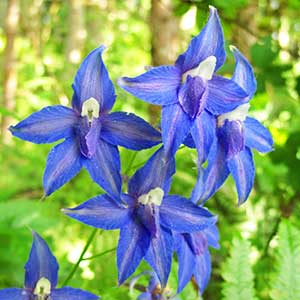Delphinium nuttallianum
Delphinium trolliifolium
dwarf, meadow, Nuttall's larkspur, or Sonne's larkspur, slim, thin-petal larkspur, two-lobe larkspur, upland larkspur
Columbian larkspur, cow-poison, poison delphinium, poison larkspur
unbranched, 10-40(-70) cm;
base reddish, pubescence variable.
(40-)60-120(-180) cm;
base usually reddish, glabrous to puberulent.
blade round, 1-6 × 2-12 cm, nearly glabrous; ultimate lobes 5-21, 5 or more extending more than 3/5 distance to petiole, width 1-7(-14) mm (basal), 0.5-6 mm (cauline), widest at middle or in proximal 1/2.
blade ± pentagonal, 4-8 × 7-16 cm, margins ± incised, nearly glabrous; ultimate lobes 0-9, width 15-30 mm (basal), 5-20 mm (cauline), widest at middle or in proximal 1/2.
4-18(-48)-flowered, at least 2 times as long as wide;
pedicel 0.8-6 cm, pubescence variable;
bracteoles 3-8(-18) mm from flowers, green to blue, linear, 3-7 mm, pubescence variable.
(5-)14-40(-75)-flowered, ± open, at least 2 times longer than wide;
pedicel 1-4(-9) cm, puberulent to glabrous;
bracteoles (2-)6-12 mm from flowers, green, linear, 5-9(-14) mm, puberulent.
sepals usually bluish purple, rarely white to pink, puberulent, lateral sepals reflexed or spreading, 8-21 × 3-10 mm, spurs decurved to straight, ascending 20-60° above horizontal, 8-23 mm;
lower petal blades elevated, exposing stamens, blue to purple, except sometimes in white-flowered plants, 4-11 mm, clefts 2-5 mm;
hairs mostly on inner lobes below junction of blade and claw, white, rarely yellow.
sepals dark blue, glabrous, lateral sepals spreading, (8-)14-21 × 5-9 mm, spurs straight or downcurved at apex, within 20° of horizontal, (10-)16-23 mm;
lower petal blades covering stamens, 5-10 mm, clefts 1.5-3 mm;
hairs sparse, mostly near junction of blade and claw, centered or on inner lobes, well dispersed, yellow.
7-22 mm, 3.5-5 times longer than wide, glabrous to puberulent.
(15-)23-34 mm, 3.8-5.5 times longer than wide, glabrous.
winged or not;
seed coat cell surfaces smooth or roughened, blunt hairs absent.
unwinged;
seed coats smooth.
= 16.
= 16.
Delphinium nuttallianum
Delphinium trolliifolium
Delphinium nuttallianum represents an extremely difficult complex, with many variations in a number of morphologic traits. The complex has been and continues to be a major source of confusion for identification of Delphinium in North America. Type specimens of D. nuttallianum represent plants growing under dry conditions in open areas. These are typically found at 1200-2000 m in sage scrub or lower montane forest. Delphinium nuttallianum may be confused with D. andersonii, D. antoninum, D. depauperatum, D. gracilentum, and two subspecies of D. patens (subsp. patens and subsp. montanum). Features that may be used to separate D. nuttallianum from the first four, are enumerated under the respective species discussions. From D. patens subsp. patens, D. nuttallianum may be distinguished by its narrower leaf lobes, larger fruits, and more compact inflorescence. The frequent presence of glandular hairs in the inflorescence of D. patens subsp. montanum, contrasted with their absence in D. nuttallianum, will separate these taxa. Dwarfed plants of D. polycladon may be confused with D. nuttallianum. The latter, however may be distinguished by its ringed seeds, and it does not have prominent buds or sigmoid pedicel.
Hybrids have been seen between Delphinium nuttallianum and D. andersonii, D. depauperatum (D. ×burkei Greene), D. distichum (D. ×diversicolor Rydberg), D. nudicaule, and D. polycladon.
(Discussion copyrighted by Flora of North America; reprinted with permission.)
Delphinium trolliifolium occurs in the northern Coast Range of California, the Columbia River Valley to just east of Mt. Hood, and the Willamette Valley of Oregon upstream to Lane County. California plants differ somewhat from Oregon plants in pubescence patterns and habitat preferences. Further study may show that two entities are involved here.
Hybrids between Delphinium trolliifolium and D. decorum, D. menziesii subsp. pallidum (D. ×pavonaceum Ewan, Peacock larkspur), D. nudicaule, D. nuttallianum, and D. nuttallii are known. Delphinium trolliifolium is likely to be confused only with D. bakeri. Refer to discussion under that species for differences.
(Discussion copyrighted by Flora of North America; reprinted with permission.)


